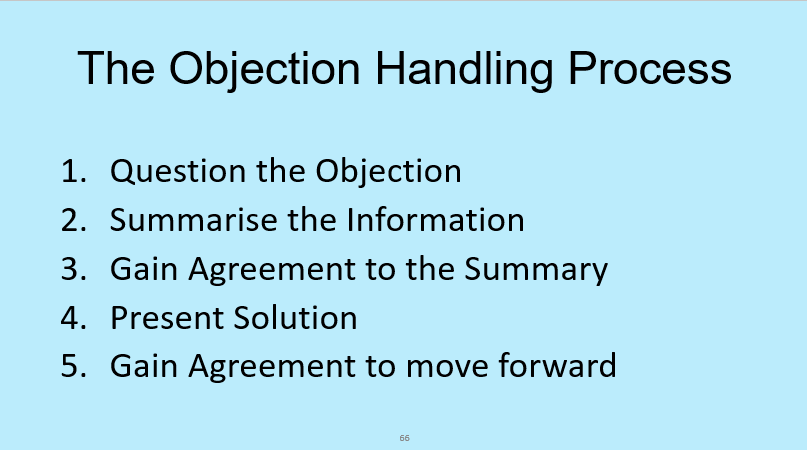sales objection responses proven to work
Stages 2 & 3 of the Sales Objection Handling Process
The most effective sales objection responses are to question the objection to define the real issue, summarise your understanding, and gain agreement to what you see as the obstacle stopping you closing the sale, then present your best solution and close the sale by gaining agreement to it.
 Slide from the sales training course Selling Success
Slide from the sales training course Selling SuccessOn this page we are at Stages 2&3 of the objection handling process - Summarise & Gain Agreement. These stages come after after you have used a questioning funnel to clearly define the sales objection in stage 1.
By defining the objection, checking your understanding with a summary, and gaining agreement you have understood correctly, you will greatly increase your success rate of handling sales objections when you present your solutions in the Presentation Stage.
To close more sales with this process, you should also gain agreement that there are no other objections, concerns, or obstacles to address before you move to the Presentation Stage. If there are, you simply loop back to the Questioning Stage so you can define the other objections before presenting your sales objection responses.
Let's start with how to summarise the information gained in the Questioning Stage...
How to Summarise - Responding to Sales Objections
If you don't check you fully understand before responding to sales objections you may be answering the wrong concerns, only offering a partial solution, or giving your best response only to be hit with another objection.
After you have questioned the objection to define it, summarise back what you understand is the issue, and gain their agreement to that summary. If the prospect doesn't agree with your summary go back to the Questioning Stage and get more information.
Reframe the Objection Response
A sales objection is usually a negative statement made by the prospect and I suggest when this happens you reframe it as a positive need or requirement the prospect has.
There are 2 reasons to do this:
- It is often easier to present sales objection responses that meet a positive need, want, or desire, than it is to counter or take away what the prospect frames as a negative feature of your products or services.
- Reframing the sales objection also moves the focus of the conversation onto a positive requirement and away from a negative discussion on how your proposal doesn't meet the prospect's needs.
When summarising your understanding of the objection use lines that say what the prospect wants the sales proposal to do for them rather than what they don't want.
Example
After presenting how an online recruitment service and job board can meet a prospect's hiring needs, the telesales caller gets the objection: I don't want a service with a monthly subscription that automatically renews and takes the payment.
The telesales person reframes this unwanted negative as they summarise their understanding of the objection by saying: If I understand correctly, you want a recruitment service that gives you the option of deciding at the end of each month whether you wish to continue your subscription.
No negatives, just a positive requirement, another feature and benefit the prospect wants. With these sales objection responses you can tailor the reframed objection to fit features or benefits that you can offer. In the above example, if the service only allows for automated subscription renewal the sales person could state the positive requirement as: You want a service that sends you a reminder of an upcoming subscription renewal with enough time to cancel if you don't wish to continue for another month.
Do this for all the sales objection responses and then gain agreement to your summary...
Gaining Agreement to Sales Objection Responses
Gaining agreement to your sales objection responses is done by tagging a simple question to the end of the summary. If there are many objections you can add an agreement gaining question after you have summarised each one.
The tagged question line can be as simple as adding a line such as: If I understand correctly, you want a recruitment service that gives you the option of deciding at the end of each month whether you wish to continue your subscription, (summary) is that correct? (agreement gaining question)
Once you have gained agreement that you have clearly understood the objection, you should ask the question: Is this the only objection.
This line asking if you now have all concerns, obstacles, or problems, can also be reframed as: If you can present a solution the prospect will buy from you because there is nothing else stopping the sale moving forward.
As with all the lines in your sales conversations, the summary and the agreement gaining question should be in your own words, appropriate for your prospects, and sound natural. A small concern over terms and conditions would be given a different response than a complex problem with a lengthy contract.
In my sales training course Selling Success, this is how I train sales people to create their own scripts for all stages of the sales process, I present the objective and purpose of each step, you create the lines to use in your own words.
Use the Sales Objection Responses
This is a powerful technique for overcoming sales objections because you are:
- Getting the full details about the objection and gaining agreement that you understand it.
- Gaining agreement that there is nothing else stopping the sale going ahead.
- Reframing the objection in the mind of the buyer and turning it into a need you can fulfil.
Sometimes, prospects dig their heels in and put their weight behind this obstacle because subconsciously it is their objection and it challenges your sales proposal. To avoid this position we are turning the head on challenge into a need and we are then on the same side as the prospect and showing them how we can work together to provide the benefits they want.
Give these sales objection responses a try, adapt the technique, play around with the words, and convert more sales meetings and calls into closed deals...
The Sales Objection Handling Process
The sales objection handling process has 5 stages. You can go to the other pages using the links below or see an overview of the process by visiting the main sales objection page at Sales Objections Process
Stage 1 - Question the Objection
Stages 2&3 - Summarise and Gain Agreement - This page
Stage 4 - Present the Solution
Stage 5 - Gain Agreement and Move Forward
- Homepage
- Sales Objections
- Sales Objection Handling Process
- Summarising and Agreement Gaining
The Sales Buzz - Newsletter Ezine
The weekly Sales Buzz eZine newsletter covers all aspects of sales with a different tip, technique, or discussion point each week.
See the latest pages to be added or updates on the Proven Sales Training website, real examples from the world of sales, and interesting innovations that sales people and businesses are using.
When you ask for the Sales Buzz to be delivered you get 2 free sales training mini-courses that are unique to this website, and we have a strict privacy policy so you know your details are kept safe.
See the 2 free mini-courses and get the Sales Buzz delivered by visiting: The Sales Buzz
- Homepage
- Sales Objections
- Sales Objection Handling Process
- Summarising and Agreement Gaining
